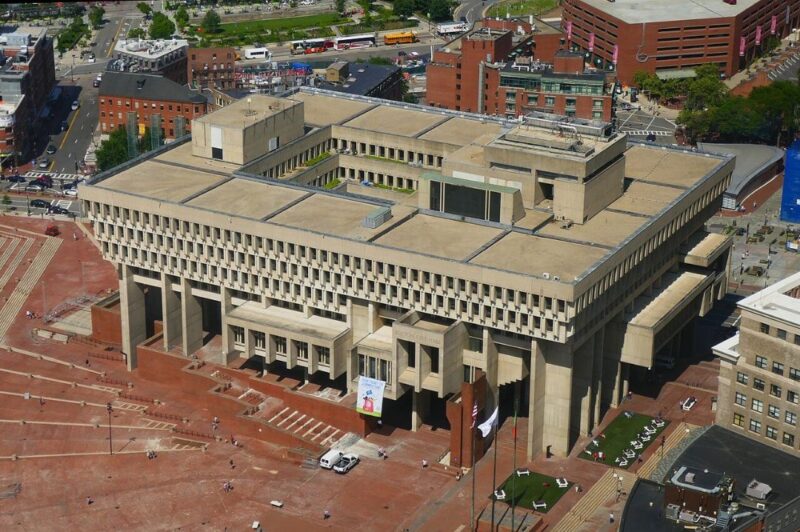If there is one building that divides Bostonians, it is the notorious Boston City Hall. This Brutalist structure looms imposingly over Boston City Hall Plaza, drawing both criticism and praise. But for many Bostonians, it is simply a source of puzzlement. They wonder why such an unusual design was selected for the city hall to begin with.
Boston City Hall was Conceived of as an Open, Transparent, Inviting Structure

The monumental concrete structure of Boston City Hall is the work of architects Michael McKinnell and Gerhard Kallmann. It was one of 256 entries into a contest in 1962. The jury that selected it wanted a structure that would invoke traditional forms, but do so in a modern, forward-thinking way.
Boston.com quotes architecture professor Mark Pasnik as explaining, “So many people call these buildings Stalinist, but nothing could be further from the truth … Kallmann, McKinnell, and Knowles did have an idea that this would be a very democratic building. They saw it as open. There’s very large columns that allow you to enter into the building in multiple ways. It doesn’t work like that anymore, but that was the original idea of that.”
The plaza also was designed with openness and freedom of movement in mind. That is why it is such an unstructured space.
A Clash of Expectations and Reception

In the quotation above, Pasnik is alluding to the north entrance, which since 2001 remained closed. But there were other ways too in which many Bostonians felt that the building and its surrounding plaza failed to deliver on the promise of its design.
Famously, Paul McMorrow complained in The Boston Globe in 2013, “Its great crime isn’t being ugly; it’s being anti-urban. The building and its plaza keep a crowded city at arm’s length. It disperses crowds, instead of gathering them together.”
Brian Sirman, author of Concrete Changes: Architecture, Politics, and the Design of Boston City Hall, explains that he initially “set out to prove that Boston City Hall was the greatest building in the history of mankind.” He explains, “As I got deeper into my research, though, I found much of the criticism of the building to be cogent and compelling … What the building says about Boston and about democratic government strikes many people as inaccurate or inappropriate, and those concerns merit serious consideration.”
Recent Renovations of Boston City Hall

Politicians and private citizens have warred over what should happen to Boston City Hall. Some even went so far as to propose demolishment. But thankfully, the city has gone the renovation route instead. In fact, in 2019, we covered some renovations made to the interior and exterior of the structure, including the addition of colorful LED lights to bring cheer and vibrancy to the façade at night.
Interestingly enough, these renovations took place under Marty Walsh, who served as Boston’s mayor from 2014 to 2021. Originally, Boston.com reports that Walsh campaigned on a plan to demolish the structure. In a surprising plot twist, the building was instead improved during the course of his time in office.

A few years ago, Sirman expressed skepticism that anything could be done to improve the plaza itself. But just last year, efforts were made to renovate the City Hall Plaza. The renovations incorporate a 12,000 square foot play area, artworks, greenery and improved accessibility.
In the end, it seems we can say that in some ways, Boston City Hall remains a work in progress. But the renovations of recent years give us hope that Boston and its people are beginning to appreciate the historical and architectural significance of the structure, and that it will ultimately be able to fulfill its promise to stand as a beacon of modernity, openness, transparency and democracy.
To read about more instances of Brutalist architecture, read up on The Imposing Brutalist Grandeur of UW’s Red Square and Pretty (and Brutalist) in Pink. And of course, don’t forget to follow us on Instagram, Facebook and Pinterest for more Mid Century Modern inspiration!












